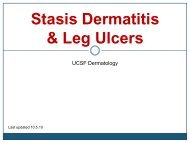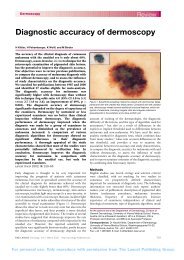An overview of sexually transmitted diseases. Part III ... - Dermatology
An overview of sexually transmitted diseases. Part III ... - Dermatology
An overview of sexually transmitted diseases. Part III ... - Dermatology
You also want an ePaper? Increase the reach of your titles
YUMPU automatically turns print PDFs into web optimized ePapers that Google loves.
J AM ACAD DERMATOL<br />
VOLUME 43, NUMBER 3<br />
Fig 6. HIV-positive patient. Oral condyloma acuminatum (ie, HPV type 6).<br />
infect the oral epithelium (Fig 6). The association<br />
between certain HPV types (eg, HPV types 16, 18, 31,<br />
and 45) and the development <strong>of</strong> dysplastic lesions in<br />
the cervix is well known. 137 The dysplastic lesion,<br />
termed a cervical squamous intraepithelial lesion<br />
(CSIL), occurs in the transformation zone along the<br />
squamocolumnar junction near the cervical os. CSIL<br />
is a precursor to cervical cancer. Similarly, the anal<br />
canal has a squamocolumnar junction and transformation<br />
zone that is affected by HPV infections.<br />
Specifically, the anal squamous intraepithelial lesion<br />
(ASIL) and invasive anal cancer appear to be associated<br />
with HPV infections, most notably HPV type 16<br />
infections. 138-141<br />
Genital HPV infections occur more commonly in<br />
HIV-infected men and women when compared with<br />
age-matched healthy control populations. 140,142-145<br />
The lesions are more frequently diffuse, dysplastic,<br />
and subclinical in HIV patients, whereas control populations<br />
more commonly have condylomatous<br />
lesions and less commonly have subclinical and dysplastic<br />
lesions. 146 In addition, HIV-positive patients<br />
tend to be infected with more HPV types than control<br />
populations. 144,147-149 As CD4 cell count decreases,<br />
shedding <strong>of</strong> HPV and extent <strong>of</strong> disease appear to<br />
increase. 150,151<br />
Given these clinical features, HPV replication and<br />
disease progression appear to be potentiated by HIV<br />
infections. 150,151 The mechanism behind this phenomena<br />
is unclear. HIV appears to influence gene<br />
transcription in HPV. 152,153 This may lead to a defect<br />
in the host’s local immune defenses and, when<br />
Czelusta, Yen-Moore, and Tyring 417<br />
accompanied by the systemic immunosuppression<br />
<strong>of</strong> HIV infection, may explain the increased severity<br />
<strong>of</strong> HPV infections observed in this setting.<br />
Regardless <strong>of</strong> the exact mechanism, it is clear that<br />
HIV-infected persons have higher rates <strong>of</strong> cervical,<br />
anal, and other genital cancers (Figs 7 and 8). Those<br />
persons most at risk are women with a history <strong>of</strong><br />
abnormal Papanicolaou (pap) smears and men or<br />
women who participate in receptive anal intercourse<br />
or have a history <strong>of</strong> anal condyloma. Not surprisingly,<br />
anal cancer is currently the fourth most common<br />
reportable cancer among HIV-positive men 154 and is<br />
about 7 times more common in homosexual men<br />
with HIV than those who are HIV seronegative.<br />
Likewise, cervical cancer in an HIV patient is an<br />
AIDS-defining illness. 38<br />
Clinically, full genital examinations in HIV-positive<br />
patients are extremely important. In women, the<br />
CDC recommends two pap smears and pelvic examinations<br />
during the first year after a diagnosis <strong>of</strong> HIV. 1<br />
If the results are normal, yearly pap smears and<br />
pelvic examinations are indicated thereafter. 1<br />
Abnormal results should be managed in consultation<br />
with a gynecologist, and current CDC recommendations<br />
regarding this issue are listed in the “Interim<br />
Guidelines for Management <strong>of</strong> Abnormal Cervical<br />
Cytology.” 155 Some research suggests that pap<br />
smears are an insensitive method to screen for cervical<br />
cancer in AIDS patients. 156 Subsequently, some<br />
experts support colposcopy as a regular screening<br />
tool in patients when they are initially diagnosed<br />
with HIV. 156 Nonetheless, a more recent study con-

















